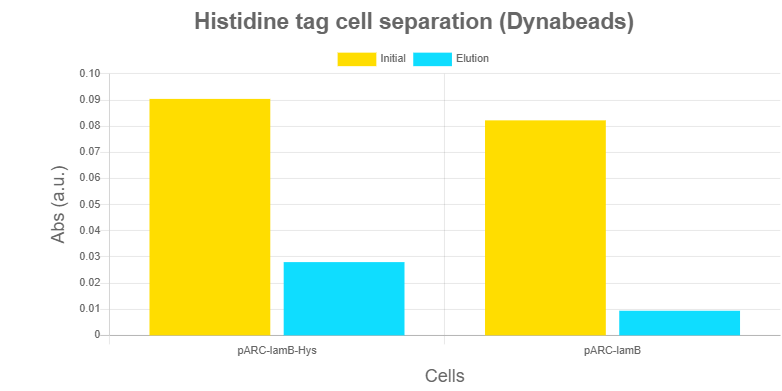Difference between revisions of "Part:BBa K3122001"
| Line 32: | Line 32: | ||
</li> | </li> | ||
</ol> | </ol> | ||
| − | + | </br> | |
[[Image:T--MADRID_UCM--dynabeads.png|thumbnail|600px|center|'''Figure 1:''' | [[Image:T--MADRID_UCM--dynabeads.png|thumbnail|600px|center|'''Figure 1:''' | ||
Histidine Tag cell separation using second approach]] | Histidine Tag cell separation using second approach]] | ||
Revision as of 22:43, 21 October 2019
6xHis Tag (Adapted to AEGIS' lamB display system)
This part is derived from BBa_K1223006. It contains 6 histidine residues, and it has been adapted to AEGIS' lamB display system in order to be used as the heterologous peptide tag expressed.
To see the design of this part go to the Design tab.
Characterization
Characterization of Histidine-based separation
Histidines are used as base of the separation system of our Robo-SELEX protocol. Several alternative strategies were designed, all based on the same concept: the LamB - 6xHis tag functions as an anchoring system, so the cell is retained while aptamers are eluted.
- First strategy: magnetic resin.
- Second strategy: magnetic beads. Following the principle explained above, we tried the same protocol with a different material, this time using cobalt magnetic beads to bind to the Histidine Tag, expressed throughout the surface of E. cholira (J. Kim, 2007).
Results
- We conducted a first assay with the magnetic resin using the maximum values for all the variables we wanted to optimize (initial concentration of cells and incubation time), and as the proportion of cells found after plating the dilutions we were unable to drag or retain enough cells. After analyzing our results, we concluded that due to the small size of the particles in the resin, they would be too compact with a pore size too narrow to allow let the cell access to the inside of the resin matrix.
- We attempted to separate the cells with the cobalt magnetic beads. We thought that the individuality of the beads, which are present in the solution without aggregating in a small-pore-sized resin, would correct those problems. An assay was conducted as a proof of concept, comparing the absorbance between Eppendorfs that suffer E. cholira separation with and without expressing the Histidine tag. So, after performing the assay in the OT2, we measured absorbance at 640nm of the resulting 96 well-plate. The results obtained in this assay showed a significant difference between the control cells pop6510 harbouring vector pARK1-LamB (without expressing the anchor systems) and the pop6510 harbouring pARK1LamB-6xHis. With this, we confirmed that there was an interaction between the Tag and the cobalt beads. After analyzing the results obtained in the assay we saw that the efficiency of the process was around 10%, which was not enough to conduct a proper SELEX protocol due to the number of aptamers in each SELEX round that we would lose in the remaining 90% of the cells.
</br>
How to use it
AEGIS' lamB display system that we created can be used by future iGEM teams on their MoClo reactions with the desired tag to create level 1 constructs. The only requirement is to adapt the tag sequence to the new scars designed, as this part has been adapted.
- 10COMPATIBLE WITH RFC[10]
- 12COMPATIBLE WITH RFC[12]
- 21COMPATIBLE WITH RFC[21]
- 23COMPATIBLE WITH RFC[23]
- 25COMPATIBLE WITH RFC[25]
- 1000COMPATIBLE WITH RFC[1000]
References
J. Kim, C. Valencia, R. Liu and W. Lin, "Highly-Efficient Purification of Native Polyhistidine-Tagged Proteins by Multivalent NTA-Modified Magnetic Nanoparticles", Bioconjugate Chemistry, vol. 18, no. 2, pp. 333-341, 2007. Available:10.1021/bc060195l.

